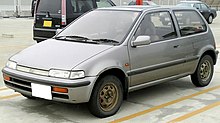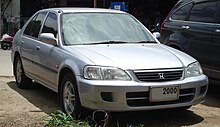Honda City History
The Honda City is a subcompact car manufactured by the Japanese manufacturer Honda since 1981. Originally made for the Japanese, European and Australasian markets, the City was retired without replacement in 1994. The nameplate was then revived for use on a series of compact four door sedans particularly aimed at developing markets, mainly sold in Asia outside of Japan but lately also in Latin America and Australia.
Since 2002, the City is also known as the Honda Fit Aria. It is a subcompact sedan built on Honda's Global Small Car platform, which it shares by the Fit/Jazz (a five-door hatchback), the Airwave/Partner (a wagon/panel van version of the Fit Aria/City), the Mobilio, and the Mobilio Spike — all of which share the location of the fuel tank under the front seats rather than rear seats.
The first Honda City (AA for sedans, VF for vans and FA for the wider Turbo II and Cabriolets) was introduced in November 1981 with the innovative "Tallboy" design; of unusual height it enabled four adults to fit comfortably in the very short City (under 3.4 m/11.2 ft).[1] Produced as a 3-door hatchback in a variety of trim levels, the City was also available together with the Motocompo, a special 50cc 'foldaway' scooter designed to fit in the City's small luggage area.
In September 1982 a turbocharged version of the 1231 cc Honda ER engine was introduced. A Pininfarina designed drop-top Cabriolet utilized the wider fenders and bigger bumpers of the Turbo II "Bulldog", but was only normally available with the naturally aspirated 67 PS (49 kW) engine. There was also a Pro-series of van versions with either two or four seats. A high-roof "R Manhattan Roof" version with a 10 cm taller roof also appeared.
Exports of the City were primarily to Europe (where it was renamed Honda Jazz, due to Opel having trademarked the City name), Australia (in two seater 'van' form, to circumvent Australian import restrictions on passenger vehicles at the time) and New Zealand (where it was locally assembled). Production ended in late 1986 with the introduction of the GA type City.
Second generation (1986-1994)
Honda replaced the original City in 1986 (designated GA1), with an update in 1989 (GA2). This model was produced until 1994. The Fit name also first appeared as a trim variant of the City. There was no convertible model. In most European and Australasian markets, the City's market position was left open until filled by the Honda Logo in 1999.Third generation (1996-2002)
The third-generation Honda City, codenamed SX8, was based on the EK Civic platform. It was designed for and sold in the South East Asian market only.This City is still a subcompact slotting beneath the Honda Civic, but a four-door sedan model instead for developing markets in Asia, and was built in Pakistan, Thailand, Malaysia, Indonesia, Philippines and India. A revised, face-lifted third-generation City was released in 2000, and included a model powered by Honda's 1.5 L VTEC engines.
The third generation city had the D-series engines, namely variations of the D13B and D15B. The D15B was reduced in power for the Asian markets where the car was sold, but its power to weight ratio remained superior to that of the competition. The kerb weight of the car was 985 kilograms (2,170 lb), and the output of the D15B engine was 115 PS (85 kW). The car had an 0-100 km/h time of around 10 seconds.
The car had a sporty suspension set-up. It was one or the rare sub-compacts with fully independent rear suspension (dropped in the later models due to its high cost) which allowed for greater feedback and enhanced handling.
Fourth generation (2002-2008)
At the Thailand International Motor Expo 2002 in November 2002, the fourth generation City made its world debut, now also offered as a four-wheel drive version. It was imported from Thailand and launched as Fit Aria in Japan domestic market[2] from December 20, 2002. In the People's Republic of China, the model got the name Fit Saloon and was sold from September 2003 to the December 2008.In September 2005, a face-lifted version of the City was launched in Thailand, Malaysia in October 2005, and Indonesia in November 2005; it is known as the City ZX in Thailand, India, the New City in Indonesia and Malaysia, and City in Singapore and Pakistan. The most significant changes are a new exterior (new front grille, new headlamps, new fog lights, new taillights and bumpers). The front end has been extended forward by 65 mm (2.6 in) while the rear has been extended by 15 mm (0.6 in). The side mirror is electronically foldable. Both the i-DSI and VTEC trim levels have 14-inch (360 mm) alloy wheels as standard equipment. Interior changes are minor but it does include an armrest for the driver and additional map lights.
The engine remains the same but the intake manifold has been modified, resulting a 10% temperature drop in the intake air temperature (IAT)[3], the suspension has been upgraded as well.
Honda City in India, Thailand, Indonesia, Philippines, Pakistan, Singapore and Malaysia are using CVT gearbox for both i-DSI and VTEC variants. The CVT gearbox simulates a 7-Speed automatic transmission with Tiptronic style override using paddle shift buttons. This is very rare for a subcompact of its class.
Fifth generation (2008–present)
 | |
| Also called | Honda Fit Aria Guangzhou-Honda City |
|---|---|
| Production | 2008–present |
| Assembly | Ayutthaya, Thailand Alor Gajah, Malaysia Greater Noida, India Guangzhou, China Lahore, Pakistan Sumaré, Brazil Santa Rosa, Laguna, Philippines Adapazarı, Turkey |
| Body style(s) | 4-door sedan |
| Layout | FF layout |
| Engine(s) | 1.3 L I4 i-VTEC 1.5 L I4 i-VTEC |
| Transmission(s) | 5-speed manual 5-speed automatic |
| Wheelbase | 2,550 mm (100 in) |
| Length | 4,395 mm (173.0 in) |
| Width | 1,695 mm (66.7 in) |
| Height | 1,470 mm (58 in) |
| Curb weight | 1,150 kg (2,500 lb) |
| Related | Honda Fit/Jazz Honda Airwave Honda Freed |
The new Honda City was unveiled in Bangkok, Thailand at Siam Paragon on the 10th of September 2008 followed by New Delhi, India on 25 September 2008[4]. and January 2009 in Pakistan and Indonesia. Honda also announced that the City will be offered in selected European countries with a 1.4 liter i-VTEC engine mated to either a 5-speed manual or a 6-speed i-SHIFT automated manual transmission.
Guangzhou Honda started selling the Honda City in China from the 12th of December 2008 onwards. Unlike other markets where the largest engine option is a 1.5 liter, the Chinese market Honda City will have an R18A 1.8 liter engine option.[5]
Guangzhou Honda is also developing a Honda Civic-sized sedan based on the Honda City chassis for the Chinese market. It will have a new name and a new shape but will use the City's underpinings and a 1.8 litre engine. This new car will compete against Dongfeng Honda's Civic and FAW Toyota's Corolla.
The Thai market Honda City comes in three variants - S model, V Model and SV model. The Indonesian market was offered with two trims, the lower-spec S and the higher-spec E with reclining seats. Both are powered by a 1.5 engine putting out 120 metric horsepower (88 kW), and both are available in manual and automatic transmissions.
Honda launched the new City in the Philippines on the 7th of January 2009 with four variants; the 1.3 A with manual transmission, 1.3 S with manual and automatic transmissions and the 1.5 E, whose automatic gearbox is equipped with paddle shifts that promote more sporty driving enjoyment. All variants are now equipped with a SOHC, 16-valve i-VTEC engines, creating an all-i-VTEC roster for Honda Cars this year. As a result, drivers need not to worry about the lack of horsepower[6].
It was launched in Malaysia on the 18th of December 2008.[7] It is scheduled to arrive in Singapore by the end of September. Honda launched the new City in Pakistan on 31 January 2009. It is being produced at the Honda plant in Lahore and is available in two variants; 5 speed automatic transmission and 5 speed manual. Both models have a 1.3 liter i-VTEC engine.
In February 2009, Honda Australia have released the Thai made City into the Australian market in two 1.5 litre variants (VTi and VTi-L). According to Honda Australia boss, Yasuhide Mizuno, the City will compete with other light sedans such as the Japanese made Toyota Yaris sedan, Korean made Holden Barina and the Thai made Nissan Tiida.[8] This will be the first City released in Australia since the 1980s. It will replace the market position used to be occupied by a former generation smaller-sized Civic.
In July 2009 City for the first time was built and sold outside Asia, with production in Sumaré Brazil. The car would be available for sale in Brazilian market first, and expoerts to Mexico and other markets in Latin America was planned from September 2009.[9] There are three trim options (LX, EX and EXL), all of them with the i-VTEC 1.5-liter flex-fuel engine that is shared with the Brazilian Fit. The power output is 115 hp with petrol and 116 hp using ethanol. Manual and automatic gearboxes are available.
This Honda City is also present in India with the engine of the 1.5 i-VTEC. This car is available in four variants : namely E MT, S MT and V MT which have manual gears and the V AT which is the automatic version. The E variant was launched recently based on customer feedback asking for changes to the interior colour and the cost. In 2009, Honda City became the best selling model of the company, with sales volume even surpassing that of Thailand, the best selling market of the model.[10] There are also two accessories packages, Elegance and Inspire. In India Honda City has been awarded as the "Car of the Year".[11]
The Honda City is sold in México with the same 1.5 litre four cylinder engine. It is sold in two trims: LX and EX both available with either an automatic or manual transmission.






It is one of the best sedan of Indian market and its spectacular looks and high performance makes its more desirable.
ReplyDeleteHonda City